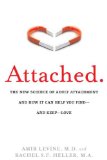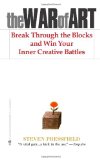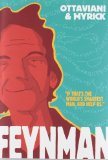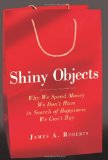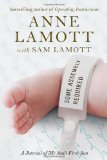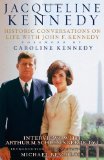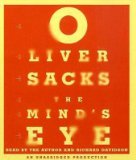Review of Attached, by Amir Levine and Rachel S. F. Heller
The New Science of Adult Attachment
and How It Can Help You Find — And Keep — Love
by Amir Levine, M. D., and Rachel S. F. Heller, M. A.
Jeremy P. Tarcher/Penguin, 2010. 294 pages.
Starred Review
Perhaps it’s silly for me, recently divorced, to read books on relationships. But I think it’s important to figure out what went wrong and how I could do better next time, if there is a next time. There’s much here that’s applicable to any relationship, not just a romantic one, and it also gives me insight into myself and what makes me anxious. What’s more, I would love to be more secure in relationships, and this book has much to teach me about that, too.
If I ever decide to seriously date again, I am definitely going to buy myself a copy of this book. I think this is one of the best guides I’ve ever read to choosing a partner with whom you can more easily build a harmonious relationship. By the same token, if my ex-husband were ever to want to reconcile, I’d buy myself a copy of this book, in order to avoid some of the mistakes of the past, which I can see clearly written here. Meanwhile, while neither of those conditions is true, I definitely have enjoyed reading the insights this book provides.
The first paragraph of the Author’s Note at the beginning sums up what the authors are doing here:
In this book we have distilled years of adult romantic attachment research into a practical guide for the reader who wishes to find a good relationship or improve his or her existing one. Attachment theory is a vast and complex field of research that pertains to child development and parenting as well as to romantic relationships. In this book we limit ourselves to romantic attachment and romantic relationships.
Some more background from the first chapter:
Adult attachment designates three main “attachment styles,” or manners in which people perceive and respond to intimacy in romantic relationships, which parallel those found in children: Secure, Anxious, and Avoidant. Basically, secure people feel comfortable with intimacy and are usually warm and loving; anxious people crave intimacy, are often preoccupied with their relationships, and tend to worry about their partner’s ability to love them back; avoidant people equate intimacy with a loss of independence and constantly try to minimize closeness.
Armed with our new insights about the implications of attachment styles in everyday life, we started to perceive people’s actions very differently. Behaviors that we used to attribute to someone’s personality traits, or that we had previously labeled as exaggerated, could now be understood with clarity and precision through the lens of attachment. . . .
What we really liked about attachment theory was that it was formulated on the basis of the population at large. Unlike many other psychological frameworks that were created based on couples who come to therapy, this one drew its lessons from everyone — those who have happy relationships and those who don’t, those who never get treatment and those who actively seek it. It allowed us to learn not only what goes “wrong” in relationships but also what goes “right,” and it allowed us to find and highlight a whole group of people who are barely mentioned in most relationship books. What’s more, the theory does not label behaviors as healthy or unhealthy. None of the attachment styles is in itself seen as “pathological.” On the contrary, romantic behaviors that had previously been seen as odd or misguided now seemed understandable, predictable, even expected. You stay with someone although he’s not sure he loves you? Understandable. You say you want to leave and a few minutes later change your mind and decide that you desperately want to stay? Understandable too.
But are such behaviors effective or worthwhile? That’s a different story. People with a secure attachment style know how to communicate their own expectations and respond to their partner’s needs effectively without having to resort to protest behavior. For the rest of us, understanding is only the beginning.
They talk about their quest to translate attachment theory into a practical guide that can help people’s lives.
We discovered that unlike other relationship interventions that focus mostly either on singles or existing couples, adult attachment is an overarching theory of romantic affiliation that allows for the development of useful applications for people in all stages of their romantic life. There are specific applications for people who are dating, those in early stages of relationships, and those who are in long-term ones, for people going through a breakup or those who are grieving the loss of a loved one. The common thread is that adult attachment can be put to powerful use in all of these situations and can help guide people throughout their lives to better relationships. . . .
This book is the product of our translation of attachment research into action. We hope that you, like our many friends, colleagues, and patients, will use it to make better decisions in your personal life. In the following chapters, you’ll learn more about each of the three adult attachment styles and about the ways in which they determine your behavior and attitudes in romantic situations. Past failures will be seen in a new light, and your motives — as well as the motives of others — will become clearer. You’ll learn what your needs are and who you should be with in order to be happy in a relationship. If you are already in a relationship with a partner who has an attachment style that conflicts with your own, you’ll gain insight into why you both think and act as you do and learn strategies to improve your satisfaction level. In either case, you’ll start to experience change — change for the better, of course.
Highly recommended for anyone who is in a romantic relationship or wants to be in one.
attachedthebook.com
tarcherbooks.com
penguin.com
Find this review on Sonderbooks at: www.sonderbooks.com/Nonfiction/attached.html
Disclosure: I am an Amazon Affiliate, and will earn a small percentage if you order a book on Amazon after clicking through from my site.
Source: This review is based on a library book from the Fairfax County Public Library.
Disclaimer: I am a professional librarian, but I write the posts for my website and blogs entirely on my own time. The views expressed are solely my own, and in no way represent the official views of my employer or of any committee or group of which I am part.
